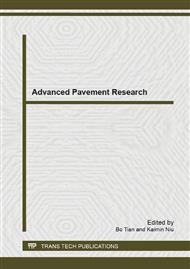p.105
p.110
p.116
p.124
p.133
p.141
p.147
p.160
p.166
Research on Early Cracking of the CRCP in the Tunnel under Low Temperature Difference
Abstract:
Calculate and analysis influence of the temperature field for Continuously Reinforced Concrete Pavement design. The temperature and crack of pavement are tested, so that the temperature changing and early cracks development inside the tunnel have been got. Studies have shown that: the tunnel temperature changes slowly, the temperature difference is small. In the first two days after concrete paving, the internal temperature of the slab was significantly higher than the ambient temperature, 79% of early cracking appears in this stages; Panel temperature rise because of the cement hydration. Strain increases in process of the growth of the concrete strength and shrinkage, the cracks appears. The number of cracks in the first two days accounted for 50% of the total number in 7 days, only the number of the second day accounted for 37.59%. Crack width accounted for 60.5% of the total, which is mainly concentrated in 0.1 mm and 0.2 mm. The crack spacing is mainly concentrated in 2m to 8m, accounted for 76.8% of all. The maximum crack spacing is 84 m, the minimum is only 0.5m.
Info:
Periodical:
Pages:
133-140
Citation:
Online since:
December 2013
Authors:
Price:
Сopyright:
© 2014 Trans Tech Publications Ltd. All Rights Reserved
Share:
Citation:


